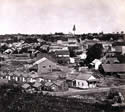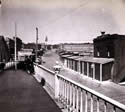"The Grass Valley Fire of 1855"
by Gary Noy
The Center for Sierra Nevada Studies
September 13, 2005, marked the 150th Anniversary of one of the most devastating events in Grass Valley history – the massive 1855 fire that destroyed the city.
Grass Valley in 1855 was a prosperous city of 3500. It had already gained its reputation as a leading mining community and was slowly developing into a desirable place to live. But that family town was still a ways off. While Grass Valley was not the rude, wild mining camp of a few years earlier, elements of that condition still remained. Saloons were common and gambling was a favored pastime. The population was very cosmopolitan as befitted the international nature of the Gold Rush, but the institutions and values of the United States predominated. Tensions between the Americans and the foreign-born were evident and reports of fights and other hostilities between them did not surprise. Women were uncommon. According to one account, in 1852, Grass Valley only had two women in town. In 1855, the numbers had increased, but still women were relatively scarce. The most famous (or infamous) woman in town was Lola Montez, the scandalous celebrity of the age.
Grass Valley becomes a city, March 1855
In March 1855, Grass Valley organized as a city. On March 5, the town incorporated and, a week later, elected city officers – featuring a five-member Board of Trustees, a Marshal, an Assessor, a City Clerk and a Treasurer. Best remembered among these first officials was the Treasurer Alonzo Delano, prominent merchant and celebrated Gold Rush Humorist/Author. Delano would play an important role in the events of September 13th.
While the new government was destined to be short lived (it was declared unconstitutional in 1856), the new Board of Trustees went right to work and quickly passed sixteen municipal ordinances. And the Town Marshal just as quickly enforced them. On his first day on the job, the Marshal made four arrests – one for fighting, one for fast riding, and he cited two women for wearing male attire in public.
The Grass Valley Board of Trustees also addressed the issue of fire, a plague that impacted most Gold Rush-era communities. Many towns up and down the Mother Lode had already suffered significant losses due to fire. The Board passed an ordinance requiring every occupant of every house to construct a container holding at least fifty gallons of water and to have four fire buckets for each story. This ordinance was never enforced – with tragic consequences.
At 11 o’clock in the evening of September 13, 1855, a fire broke out in the United States Hotel on Main Street and quickly spread. Cries of “fire” echoed through the lonely streets. And soon the population was battling the rapidly growing blaze. In their 1880 History of Nevada County, authors Thompson and West described the ensuing chaos: “All was confusion; the flames were crackling and roaring, licking up the tinder dry buildings in their pathway, and all the undirected efforts of the excited people were futile to stay their onward march. Buildings were pulled down, buckets of water by the hundreds were thrown upon the burning houses, wet blankets and other devices were resorted to, but to no avail, for the frame buildings, dried in the long summer sun, burned too fiercely for the flames to be subdued. All night they fought with tireless energy, and never ceased the struggle until the flames expired for want of food to live upon.”
The destruction was enormous. More than three hundred buildings were destroyed in an area covering thirty acres. In the downtown business district only two structures escaped. Every hotel and boarding house was ruined. Residents lost their savings and important documents to the fire. All seemed hopeless. Contemporary records indicate that the loss of property was valued at $400,000 – in today’s money; this loss would be $8.5 million.
Enter Alonzo Delano
 It is at this point that Alonzo Delano enters to save the day and the town.
It is at this point that Alonzo Delano enters to save the day and the town.
City Treasurer Alonzo Delano was not a miner. Upon his arrival in California during the early days of the Gold Rush, he mined the miners as a merchant in various Mother Lode boomtowns. Mostly he failed, and gravitated to San Francisco where he established a business in 1850. There he prospered, eventually moving to Grass Valley. In Grass Valley, he set up additional shops and became a banker and, most importantly, the local Wells Fargo agent. Delano was also a writer of note, whose sketches of gold camp life rivaled Bret Harte and Mark Twain in popularity. Under his pseudonym “Old Block,” Delano wrote for a number of California newspapers about Gold Rush characters and incidents.
Among Delano’s writings was a description published in 1856 in "Old Block's Sketch Book" of the devastating fire.
Delano wrote glowingly of the calmness and determination of the townsfolk: "On the eventful night which laid our town in ruins, which left us no cover for our heads but the blue vault of Heaven; ... did you hear one word of wailing - one single note of despair? No, not one."
Delano modestly failed to inform his readers that he had been instrumental in the town's recovery. One of the few items to survive the blaze was the Wells Fargo vault. As the town still smoldered, Alonzo Delano wheeled a tiny shed to the location of the now-incinerated Wells Fargo Office, near today's Holbrooke Hotel. This crude structure would serve as the temporary office. The warm-to-the touch, ash-covered vault was unsealed, and the important documents and currency inside were untouched by the flames.
Delano gave hope to the weary population. And they would never forget.
Delano was so admired that upon his death in 1874, all the businesses in Grass Valley suspended operations in tribute.
Following the fire, Grass Valley quickly rebuilt. Before the end of the year, new businesses and homes dotted the blackened hills.
Surprisingly, Grass Valley did not organize a regular fire department for three more years.
Painting of Grass Valley in 1858 - click to enlarge




